Before applying any pesticides read and follow all label directions. If you have any questions please call your local county or state regulatory officials.
ADELGIDS

ADELGIDS – © US Forest Service
Adelgids are aphid-like insects that feed mostly on conifers by withdrawing sap from the host plant. Adelgids are differentiated from aphids in that they usually cover themselves with a waxy coating.
Healthy trees and shrubs can tolerate a fair amount of these pests without much damage. But when damage from adelgids does occur it shows up as branch dieback, growth deformation and in severe infestations even death of the host plant.
Because of the waxy coating mature adelgids are difficult to control with topical insecticide sprays. The best control is to treat young, unwaxed insects with insecticidal soaps and waxed stages with systemic insecticides.
APHIDS
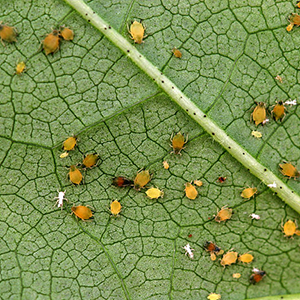
APHIDS – © Dr Lewis Wilson
Aphids are small, pear shaped soft bodied insects with long slender mouth parts used to suck out plant juices from leaves, stems and other tender plant parts. What distinguishes most aphids from all other insects is the presence of tube-like structures called cornicles projecting backwards out of the hind end of their bodies. Aphids may be brown, red, yellow, green or black.
Aphids feed upon almost every plant species and in low to moderate numbers are usually not damaging to host plants. However, large populations can cause yellowing of the leaves, curling, stunting of shoots and premature leaf drop. Aphids can also produce a honeydew which often turns black with the growth of a sooty mold fungus. Some aphids inject a toxin into plants causing additional distorting growth and some species can also cause gall formation.
Aphids seldom kill mature plants although the unsightly damage they can cause may warrant control. As aphids have many natural predators take care to apply pesticides only where they are present so as not to reduce predator populations. Many insecticides, soaps and oils are available for the control of aphids.
LACEBUG

LACEBUG – © gailhampshire
Lacebugs are small insects about 1/8 inch long and are found on the underside of leaves. Adults thorax and forewings have a distinctive multicolored pattern of dark, pale, and clear lacelike areas. Nymphs (adolescents) are wingless, smaller oval and usually have body spines. Adults and nymphs are found together in groups.
Lacebugs feed on leaf sap causing leaf stippling and bleaching. In most cases this does not seriously harm plants. Lacebugs have many natural predators that keep populations in check but if damage becomes intolerable many insecticides, soaps and oils are available for their control. No treatment will restore damaged foliage, which will remain until it is pruned off or replaced by new growth.
SAWFLY LARVAE
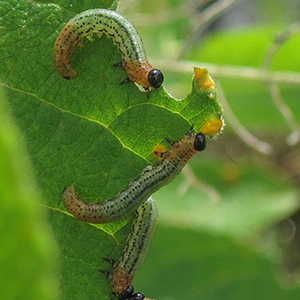
SAWFLY LARVAE – © Bj.schoenmakers
Sawfly larvae look like caterpillars but they are the larvae of wasp-like insects. This pest prefers mugo and table top pines but will also attack Scotch, Red, Jack, and Japanese pines. The larvae feed from the tip of the needle to the base and move from branch to branch stripping the needles. With heavy infestations trees may be completely defoliated. They feed on older foliage and rarely attack new growth. Since the new growth is rarely attacked tress will survive but may be severely stunted and be visually unappealing.
Small populations can be controlled by sharply striking the infested branch knocking the insects to the ground. If an insecticide needs to be applied spot spraying the individual colonies is usually sufficient.
JAPANESE BEETLES
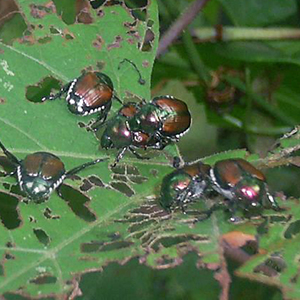
JAPANESE BEETLES – © Luke
Japanese Beetles are one of the most destructive pests to the landscape. They are easily identified by their metallic green body and copper-brown wing covers. Adults emerge from the ground and begin feeding on plants in June. Japanese beetles feed upon the leaves of about 300 species of plants but will also eat flowers and overripe or wounded fruit.
The most active feeding lasts about 4 to 6 weeks. Adults feed on the upper surface of the foliage, chewing out tissue between veins giving it a skeleton-like appearance. Adults are very mobile and can infest new areas miles away.
Japanese Beetles begin laying eggs soon after they emerge from the ground and mate. Eggs hatch by late August as a white grub which then begins to feed on the roots of grass plants. The grubs will continue to feed until the ground freezes and then over-winter 4 to 6 inches in the ground. In the spring the grubs return to the root zone of the grass plants feeding for about 4 to 6 weeks, pupate and then emerge in June again as another generation of adult beetles.
Preventative insecticide applications may be needed on host plants known to be prone to infestations. Insecticide applications should be applied as soon as the beetles are observed and may need to be reapplied to prevent re-infestation. Beetle traps are another popular control method. Unfortunately some research has shown that beetle traps attract many more beetles than are caught resulting in more damage than if no traps were used at all.
SPIDER MITES
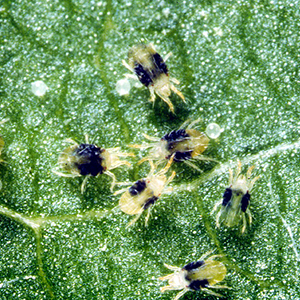
SPIDER MITES – © division
Spider mites are a common pest found on many different plants around the landscape. Spider mites are very small and are difficult to see. They are generally observed on the underside of affected plants and appear as tiny moving dots to the unaided eye. Their colors range from red and brown to green and yellow. Most spider mite species produce a silk webbing distinguishing them from other mites.
Spider mites cause injury to plants as they feed , damaging cells with their sucking mouthparts while ingesting sap. Damaged areas appear marked with many small, light flecks or spots, giving the plant a speckled appearance. Following severe infestations the leaves become discolored, producing a light gray or bronze look. Ultimately the leaves become scorched and drop prematurely. It is common with severe infestations for spider mites to kill the host plants or cause serious stress.
Spider mites have many natural predators that keep populations in check. Topical insecticide applications may in fact increase populations of mites as the natural predators are often killed off and the insecticide has little to no effect on eggs that have already been laid. Systemic insecticides, insecticidal soaps and horticultural oils seem to work best when treatments are necessary.
SCALE
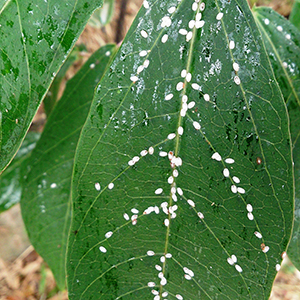
SCALE – © Mokkie
Scale are insects that are typically found on woody and foliage plants on the underside of the leaves, twigs, stems and on some hosts the upper side of leaves. The first nymphal instars are crawlers that can move short distances while later instars permanently attach themselves to leaves and twigs and feed upon sap from plants and cause yellowing of leaves and overall plant decline. Honeydew excreted by scale also disfigures plants while attracting ants which then carry the scale to uninfected plants. The excreted honeydew also acts as a protective coating protecting them from predators.
Treatment is generally needed if scale are present. The optimum time of control is when the crawlers are present as adults are difficult to control because of the protective coating.
LEAF MINERS
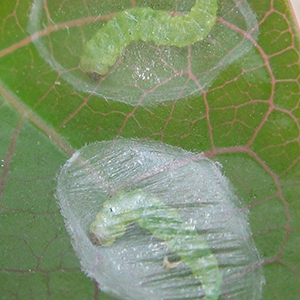
LEAF MINERS – © Ton Rulkens
Leafminers are the larvae stage of several kinds of insects including moths, beetles, sawflies and flies. Leafminers feed within the epidermal layers of a leaf producing large blotches or meandering tunnels. Areas mined by the insects dry out and die. Damage from leafminers is usually cosmetic and do not pose any significant threats to the plants health. Since leafminers have many natural predators that keep populations in check insecticide applications usually are not needed. However, if control sprays are needed topical sprays applied to leaves must be timed to coincide with periods of egg laying. Otherwise, systemic insecticides must be used to reach inside the plant tissue to provide some control.
RUSTS
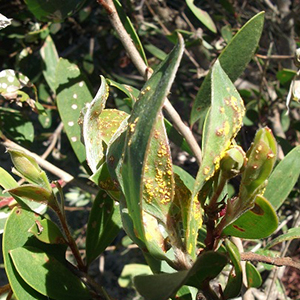
RUSTS – © Brisbane City Council
Rust is a fungal disease that comes in many forms and attacks virtually all plants, grasses, trees and shrubs. It can affect leaves, fruits, buds, stems, trunks, flowers and roots forming unsightly legions, large spores and galls. Most but not all outbreaks are characterized by dark brown, reddish-brown or orange-yellow galls or fruiting bodies.
Proper cultural practices are the cornerstone of any management program to help plants deal with imposed stresses which may lead to disease attack. Therefore, proper mulching, irrigation, soil nutrient and pH management are key. Selecting and planting disease resistant varieties also reduces disease outbreaks in the landscape.
Proper timing of fungicides may help to manage rust diseases.
APPLE SCAB

APPLE SCAB – ©
Alan Buckingham
Apple scab is a fungus that attacks the leaves of crabapple trees. Brown to olive-green spots appear that eventually turn black causing the leaves to turn yellow, curl and prematurely drop. In some years it is not unusual for trees to suffer complete defoliation by the end of June.
The best management practice is the planting of disease resistant cultivars of trees as apple scab is very difficult to control with fungicides. There are many resistant cultivars available today. Crabapples that are susceptible to apple scab need to be sprayed with a fungicide each year on a regular schedule to prevent infection. A fungicide needs to be sprayed before flower buds begin to show pink. Then the fungicide needs to be re-sprayed every 7 to 10 days for 4 to 6 weeks.




